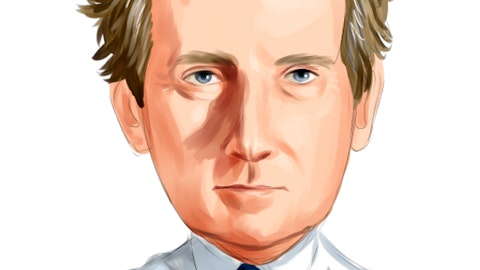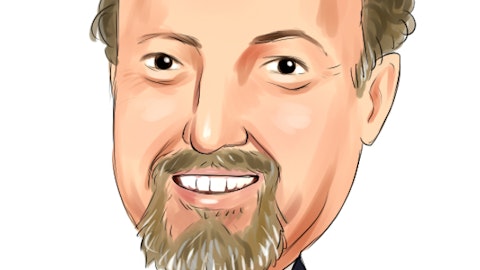Ruplu Bhattacharya: Okay Phil, thanks for the details there. If I can sneak one more in. OpEx as a percent of gross profit, is that at a stable level now? It looks like it’s been in the 62% of gross profit over the last couple of quarters. Or do you have more levers to take out costs? So how should we think about OpEx going forward? Thanks.
Ken Jacobson: This is Ken. I would say, I wouldn’t think about additional cost takeout. Clearly depending on market conditions, we may have to tighten our first strings a little bit, but no significant actions planned at this time at these levels of sales. And so I would say, it’s a pretty stable percentage at this level of sales.
Ruplu Bhattacharya: Okay. Thanks for all the details. Appreciate it.
Ken Jacobson: Thanks, Ruplu.
Operator: Thank you. Our next question is from Matt Sheerin with Stifel. Please proceed with your question.
Matt Sheerin: Yes. Thank you. Phil, I’m hoping that you can be a little bit more specific on the book-to-bill ratios that you’re seeing by region? And then on the push-outs that you’re seeing from customers, are you seeing cancellations as well? And as you’ve gotten through the quarter so far has that gotten worse or stabilized?
Phil Gallagher: Yes. Thanks Matt. So on the book-to-bill, yes, we don’t provide it at a regional level but we’ll just share that we’re — as we said in the script, we’re negative book-to-bill or below parity now in all regions. I would say, the one that’s closest to parity is still the Americas then Europe then Asia, okay? So — and I said this before they’re moderating, but I don’t see that as a negative thing. We’ve had such a run-off of positive book-to-bills that were excessive as we all know on the call that this is I think a natural and healthy moderation of the book-to-bill. So, it’s not — really doesn’t have any overly concern. And because a lot of this, to your second part Matt is, I want to say, suffered, but we’re managing the backlog.
We’re working with our customers on this. And there’s certainly as the market shifts still reluctant to cancel. I mean, so we’re having to do some of that form if you will in the backlog. They might be rescheduling, which push out. But our cancellation rates and I’m looking at the chart now as I’ve said in previous calls our buffer €“ our shock absorber in backlog is roughly 25% to 30% adjustments in any given day, where we’re either pulling in pushing out canceling. Right now, we’re running between roughly around 27%. So, it’s up a couple of points, but nothing that’s overly alarming. And again, we watch that on a daily basis. So, that’s how we’re seeing it. I mean, I think, I don’t think, it’s a negative thing. I think, it’s an adjustment in the market that, the market is required.
Matt Sheerin: And you commented previously on a question regarding seasonality next quarter. It sounds like you’re saying that even though Europe and North America will be below seasonal they’re both going to be up sequentially?
Ken Jacobson: Matt, I would say, flat to down slightly, and then Asia obviously down. And that’s where the drop in revenue comes from. But I think just to remind everyone, when we move into our third and fourth quarters we’ve got a higher mix of Western sales. So, we offset some of that sales decline by higher gross margin, because of the more favorable mix.
Matt Sheerin: Okay. So Europe too. Okay. Okay. Great. And then just lastly on the inventory, it looks like your inventory was up roughly 40% year-on-year. Your guiding revenue you’re down modestly year-on-year. You talked about customers pushing out orders. Can you do the same thing? Are you turning around and canceling or pushing out orders to your own suppliers to try to start working this down?
Phil Gallagher: Yeah. Everyone is a one-off Matt. every supplier depending on the commodity has different €“ we’ve got different NCNRs non-cancel non-returnables and all those things in place. But where we can, we certainly are. And we’re also working out with our customers. So, we do believe, as we say, we’ll start turning that inventory. The inventory is good inventory. It’s fresh inventory. We have a customer that needs some help for a challenge. And we’re in it for the long haul. So we may be carrying a little bit more than we would for some customers, because we want to work with them for the long term, and not force them to take something we know they’re not going to be able to pay for or don’t want or need. And that’s not €“ that doesn’t bode well for the relationship.
And again, we’ve been in this situation before it’s not our first rodeo, but €“ yes, it’s a constant negotiation of all one-offs. I will say the positive is, we’re not seeing suppliers ship early. We’re not €“ so I think that’s a really important point. So €“ I’m sure I’m going to get that question. But €“ so it’s just, they’re catching up, based on lead times coming in okay, and then we’ve got to work with the customers to see what other parts they need to finish out their builds.
Matt Sheerin: Got it. Okay. Thanks, Phil.
Phil Gallagher: Thanks, Matt.
Operator: Thank you. Our next question is from Jim Suva with Citigroup. Please proceed with your question.
Jim Suva: Thank you, Phil and Ken. Phil, when you were away from Avnet for a little bit of time, there were some supplier relationships that kind of went up for bid had some changes. Some of them adversely affected Avnet. Some of them did not. Now that, we’re exiting COVID are the suppliers coming back and talking about changes or new terms or anything different? Because it seems like the past two to three years it’s been anything but stable. Thank you.
Phil Gallagher: Yeah. Thanks, Jim. Yeah, those were some interesting years. They’re behind us, with the supplier, I’ll say destabilization. No, I think the supplier €“ supplier ratios have been extremely positive. And we even note that, when it comes to things like demand creation they’re actually leaning on us more as we saw our demand creation numbers go up again this quarter to some record numbers. So I think that, the supplier relationships are strong partnerships as they are relationships and they’re actually asking us to do more for them. So now, I’m very open about this. We don’t sit in the boardrooms. We don’t know, who’s looking to potentially buy who, and that we can only control how well we execute for them. And when we look at the top suppliers on the semi side and the top suppliers on the IP&E side, we’re pretty much number one or two with every one of them. So, conversations right now are very strategic and very positive as we sit here today.
Jim Suva: Yeah. And €“ no I didn’t mean that in a negative way like share losses or disengagement in a minute. Just as far as discussions could they potentially be evolving into more demand creation or more services are holding or consignments that didn’t happen pre-COVID?
Phil Gallagher: Yes. So, thanks, Jim. So what €“ some of the suppliers are acknowledging that customers are looking for as much around solutions as they are chips €“ they want total solutions, right? Board solutions not just chip solutions. And that’s where we can offer that value of the chip plus the balance of the solution for the customer. So €“ and as engineering resources to become more and more scarce and difficult to get and more on the software side, the suppliers can scale with us and we’ve got the reach to help them get to that other customer base that they may not be able to get to. So in that regard I mean there’s not a meeting we have with the supplier that we’re not talking about demand creation. A matter of fact, it’s the first thing you want to talk about.
And then on the supply chain as we call Supply-Chain-as-a-Service or our Avnet Velocity business we’ve had more suppliers coming into us and large OEM customers say, “Hey we need some help in building out the supply chain capabilities. The suppliers want to drive R&D manufacturing, sales and marketing and you know us for some of our supply chain capabilities. So I think that’s been a real positive through these last 2.5 years and I think it’s very sticky.
Jim Suva: And then maybe a follow-up for Ken. Ken, you mentioned premier Farnell’s margins came €“ come down a little bit some of it due to sales, some of it due to the removal of the premiums that happened during the shortages. I’m wondering have those premiums now been largely or completely resolved, or are those premiums still coming out of the model, where we should model a little bit more margin compression in the quarters ahead? Thank you, gentlemen.
Ken Jacobson: Yes. So Jim, thanks for the question. I think how I’d look at it would be €“ and I think I said this in the commentary where it was really €“ they’ll have a seasonal uplift in sales because they’re more of a Western kind of business but that will be offset by the continued unwinding. So I’d say €“ I don’t know, if I’d say most but over half, but there’s still some to go. And so that’s kind of what we’re expecting as a flattish or a stable margin €“ operating margin because you have higher sales offset by some further pricing deterioration to get to a steady state. And we do see positive signals, especially when it comes to what we just talked about with product availability, the single-board computers and the components needed we see that being a positive momentum going into our fiscal year 2024.
Jim Suva: Well, thank you, Phil and Ken. Congratulations to you and your teams for navigating a very challenging time.
Ken Jacobson: Thanks, Jim





